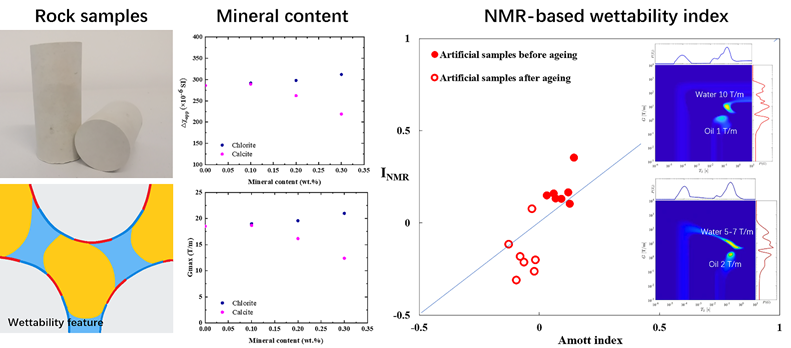Potential NMR-based wettability index for rocks
Published 05 July, 2023
Reservoir wettability plays a crucial role in determining how oil and water are distributed and affects the success of enhanced oil recovery methods in oil exploration and development. However, as more complex wettability formations, like tight oil and shale oil formations, emerge, accurately estimating wettability has become a challenge. To that end, researchers have discovered that nuclear magnetic resonance (NMR) can be a powerful tool for characterizing wettability.
In a recent study published in the KeAi journal Magnetic Resonance Letters, a team of researchers in China proposed a new NMR method for evaluating rock wettability. Their approach utilizes the magnetic susceptibility contrast between the rock skeleton and saturated fluids. This method enables petrophysical analysis of rocks with varying wettability due to mineral differences, particularly in cases of heterogeneous wettability.
"Wettability knowledge and understanding has always been a challenge for unconventional reservoirs, which drives the development of an applicable characterization method for quantitative description," explains lead author Lizhi Xiao, professor at China University of Petroleum-Beijing. “The transverse relaxation time (T2) measurement has been accepted as a rapid method for determining wettability.”
The development of NMR- T2 based wettability indices stemmed from the observation that T2 surface relaxation of the water phase indicates water-wet areas, while T2 surface relaxation of the oil phase indicates oil-wet areas. However, when it comes to intermediate wettability, where both water and oil can interact with surfaces displaying water-wet and oil-wet characteristics, relying solely on T2-based methods may lead to inaccurate assessments of wettability and predictions of fluid distribution in reservoirs.
The researchers observed distinct internal gradients for water and oil, which were influenced by variations in magnetic susceptibility contrasts within artificial sandstone samples exhibiting heterogeneous wettability. This finding implies that utilizing the contrast in magnetic susceptibility and the resulting internal magnetic field gradients could serve as an alternative approach for characterizing wettability.
"In previous studies, we used one-dimensional T2, two-dimensional diffusion and T2, two-dimensional T1 and T2 in previous publications, as well as internal gradient and T2 mentioned in this study to characterize rock wettability. These approaches can be selected based on lithology and usage conditions,” says the first author Can Liang, lecturer at Changzhou Institute of Technology. "In this study, we are conducting additional experiments to test the effectiveness of the method for generalization.”
The team hopes that their innovative method will help in advancing the understanding of wettability features in oil shale and tight oil formations.

Image: How a potential NMR-based wettability index is proposed. CREDIT: THE AUTHORS
Contact author name, affiliation, email address: Can Liang, Changzhou Institute of Technology, Jiangsu Changzhou, China. liangc@czu.cn.
See the article: Liang, C., Jia, Z., Xiao, L., Wang, G., Mao, Y., & Ma, X. (2023). A potential NMR-based wettability index using free induction decay for rocks. Magnetic Resonance Letters.

